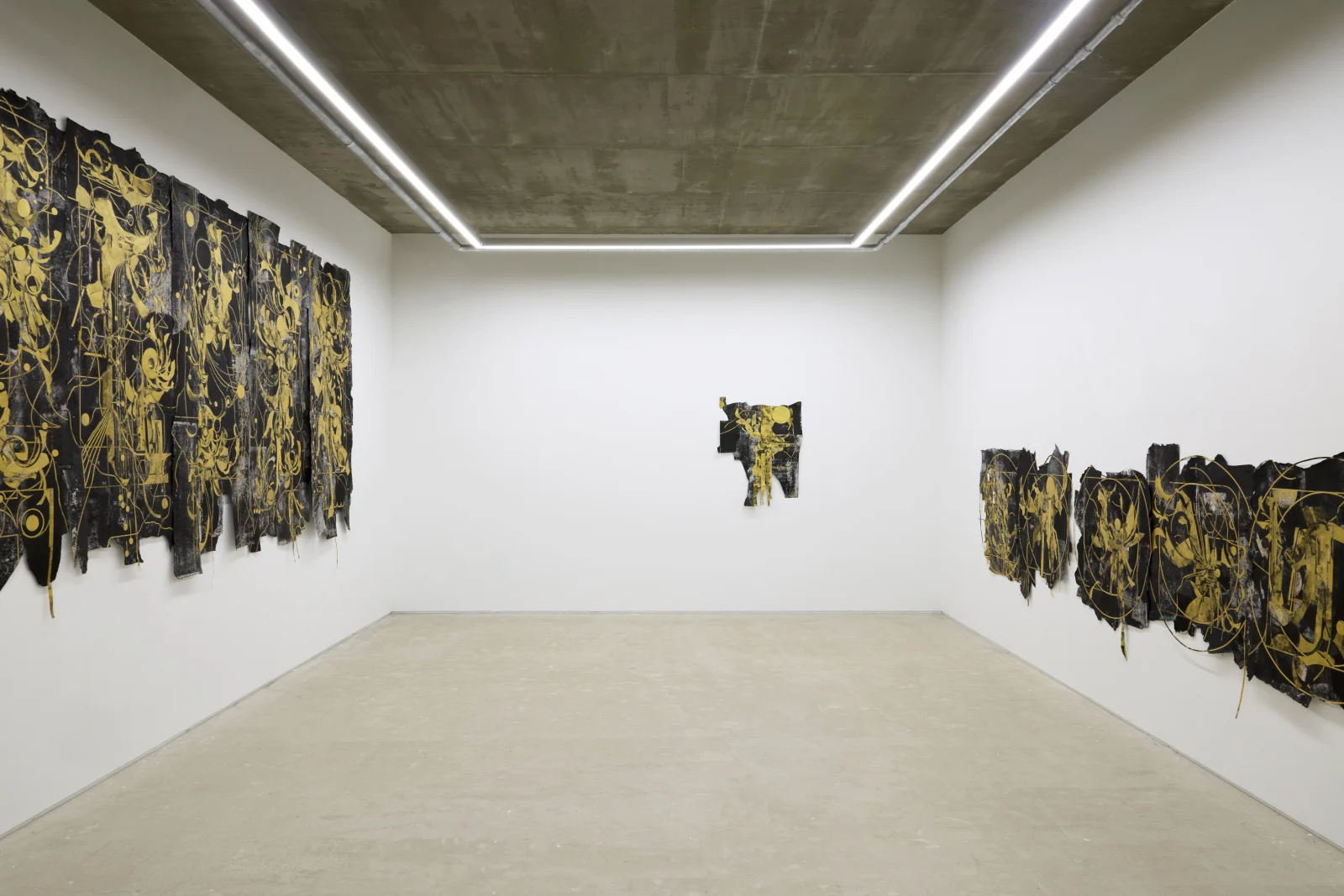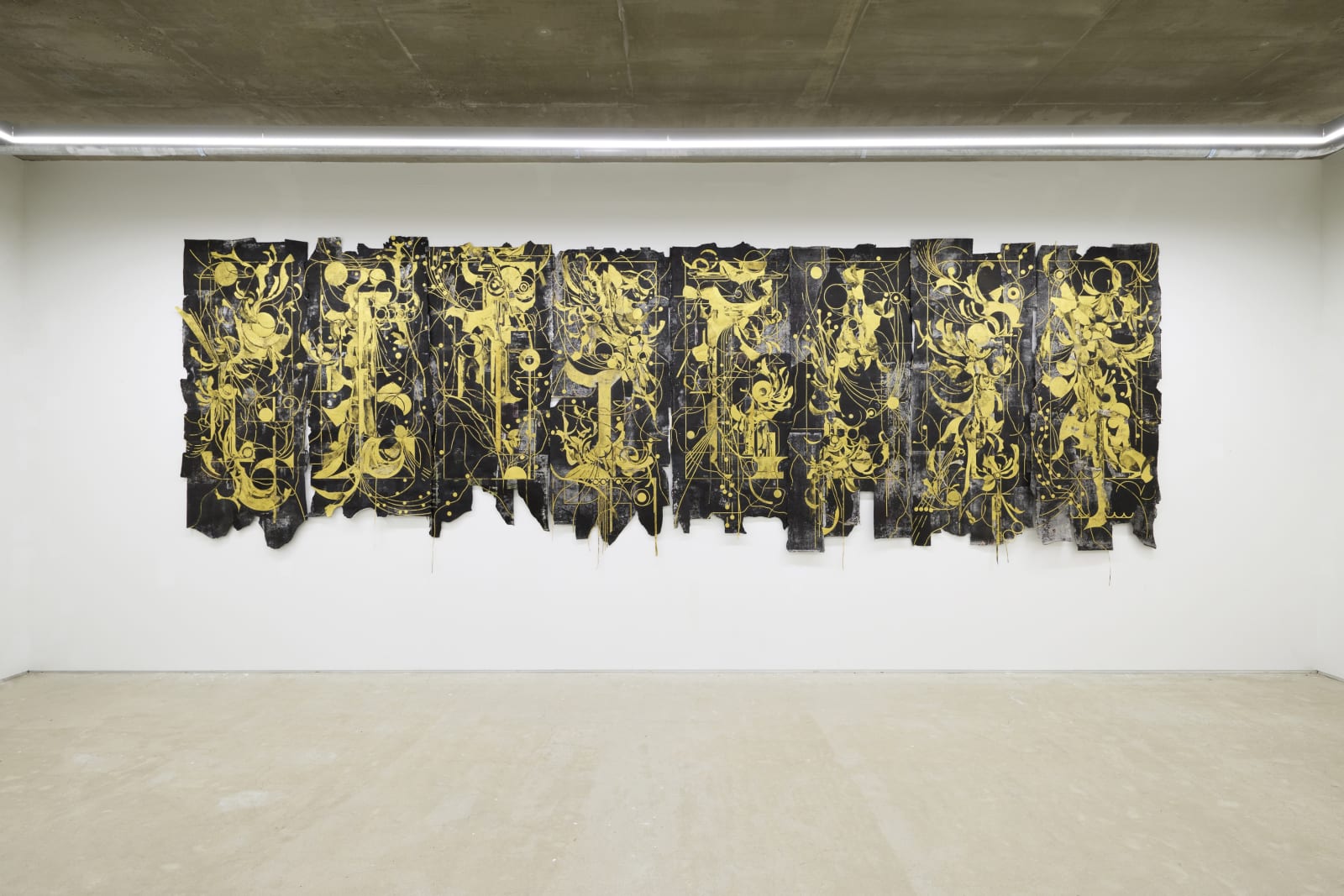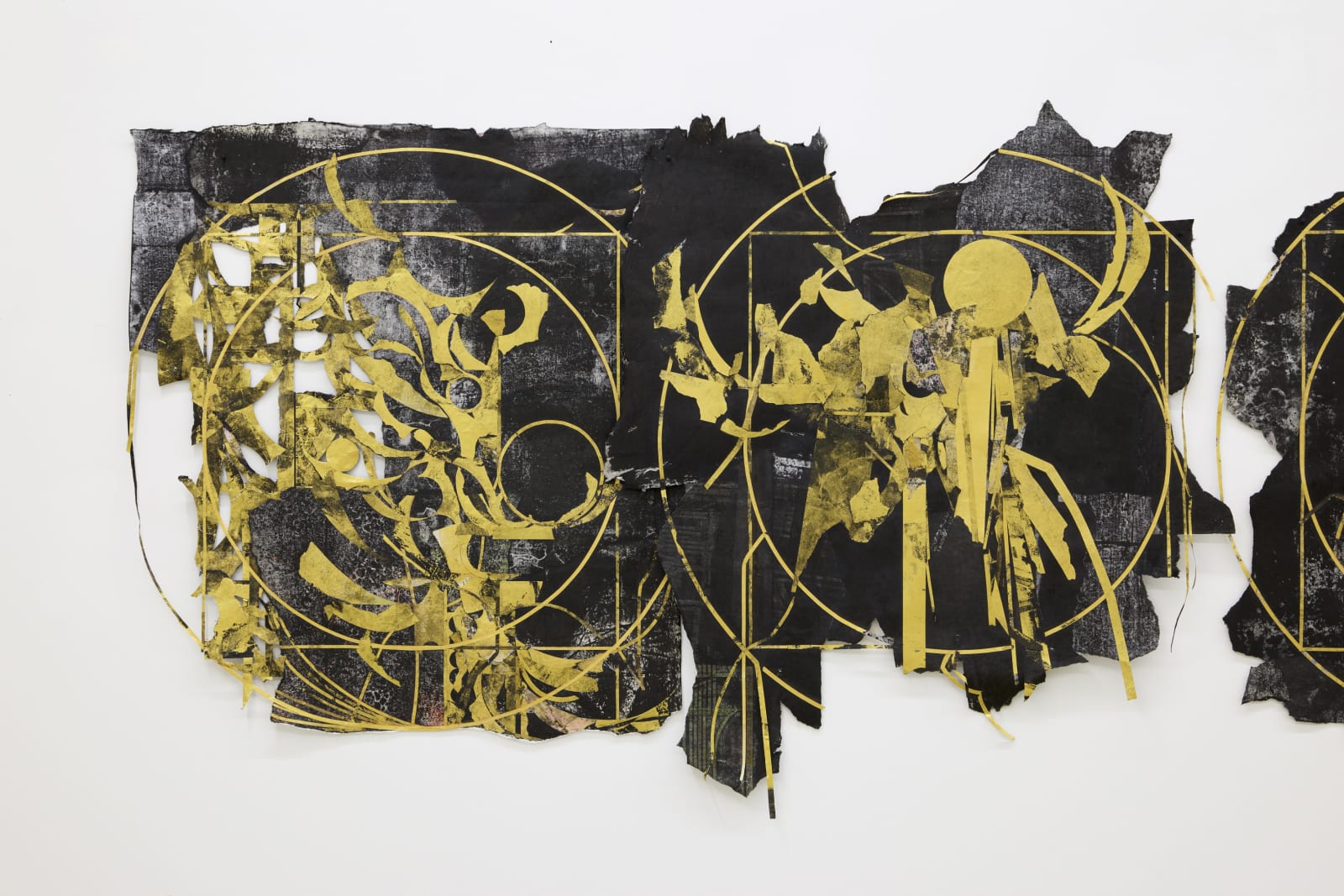Exhibition
Genealogy of Traces
세보

INSTALLATION VIEW “Genealogy of Traces”, 2025. Courtesy of the Artist and GALLERY2.
The foundational principle of Lee Sojung’s painting is the fragment. For the artist, a fragment is not a remnant of a lost whole, but an active trace that, in itself, reveals the world’s unseen interstices. Images and materials on the canvas are detached from their original contexts and reattached into new relationships, engendering a new order. Here, the genealogy (jokbo) that Lee Sojung invokes is another form of continuous succession (gyebo), one written with scattered pieces. This exhibition, Genealogy of Traces[1], explores this reconfigured genealogy, tracing the paths of these fragments and illuminating Lee Sojung’s approach to understanding the world through an amorphous narrative.
This creative methodology is structured around the four series that comprise the exhibition: Unfenced 1-17[2], Genealogy of Traces[3], Self-Harvest[4], and Overripe Leaf[5]. Each of these series is founded upon fragments left over from the artist’s previous work. Each work takes familiar objects or landscapes as metaphorical images, only to reassemble them into inscrutable structures. The artist gathers scattered paper pieces and covers them in black meok (ink), where the color black acts not as an erasure that fully removes past traces, but as a concealment that becomes the genesis for new form. The golden forms layered atop this guide the development to its next stage, confirming the amorphous expansion of her practice. Like a quest to find order among fragments, the series intersect one another, moving through repurposed failures, sutured interruptions, and the transformation of what has vanished.
Unfenced 1-17 embodies the agricultural metaphor its title suggests. Just as nōji in the Korean title refers to land free from artificial control, the artist begins on an amorphous ground, setting only minimal parameters of 160×70cm and 70×70cm, constructing eight large-scale works and smaller square canvases. However, as sloughed-off paper and suspended fragments from previous works move freely across the inside and outside of the frame building form, the initial boundary is neutralized and the canvas expands unpredictably. This process, where intention collides with chance and intervention repeats, evokes the uncertain fate of densely planted crops that must survive while fully exposed to the elements
The title series, Genealogy of Traces, delves deepest into the artist’s concept of auto-genealogy. This work is a canvas of accumulation, built from the layered fragments of previous works, including Unfenced 1-17. While a traditional sebo documents linear, patrilineal succession, the artist subverts this concept. She undertakes the paradoxical act of generating a new lineage precisely through the absence of a conventional one. Fragments of old works become fertile soil for new forms, while gilded shards suture the traces of rupture to create new connections. This logic of a self-circulating ecosystem continues in Self-Harvest, a title signifying the act of cultivating the next generation, recombining fragments collected from Unfenced, which serves as the mother plant.
Meanwhile, Overripe Leaf, which hangs from the ceiling down to the floor, channels an overflow of time. The title alludes to the moment of transformation beyond maturity when a leaf becomes sustenance for the next life. Lee Sojung established a vertical length of four meters, repeatedly painting, detaching, and reattaching sections that had already passed. In this process, the added papers generate endlessly new textures, appearing like an organism that never ceases to grow. The eight circular golden forms, stamped at regular intervals on the long paper, echo the eight-panel structure of Unfenced 1-17. They obscure the traces of a pre-existing story while simultaneously calling forth a new order built upon them. Through this, her painting is transformed not into an end, but into a preparatory stage for the next beginning.
Instead of restoring a narrative through fragments, Lee posits rupture and incompleteness as the very conditions of creation. The fragment is at once evidence of lack and fissure, and a revelation of the possibility for a multi-layered genealogy to germinate through that very gap. As the title Genealogy of Traces suggests, genealogy in her work ceases to be a diagram of hereditary succession and is reborn as a record rewritten with discarded remnants and the traces of failure. The black paper, the golden shards, and the amorphous pieces are prepared for a new order as they pass through, flow over, are collected by, and carried over the rectangular frame. Within this overlapping structure of record and creation, rupture and connection, Lee Sojung’s painting affirms the incomplete, thereby posing new questions about the narrative conditions facing contemporary painting today.

INSTALLATION VIEW “Genealogy of Traces”, 2025. Courtesy of the Artist and GALLERY2.
이소정의 회화는 파편을 다루는 방식에서 출발한다. 그에게 파편은 사라진 전체의 잔여가 아니라, 세계 내부의 간극을 드러내는 흔적이다. 화면 위의 이미지와 재료들은 본래 맥락에서 이탈하여 재배치되며, 그 과정에서 새로운 질서가 생성된다. 여기서 이소정이 호출하는 족보는 흩어진 조각들로 쓰여지는 연속적인 계승(계보)의 또 다른 형식이다. 《세보》는 그러한 파편의 흔적을 따라 재편되는 계보를 탐색하며, 비정형화된 서사로 세계를 이해하려는 이소정의 태도를 조명한다.
전시는 네 가지 축―〈노지 밀식(露地 密植) 1–17〉, 〈세보 世譜〉, 〈채종 採種〉, 〈과숙엽〉으로 구성된다. 이는 모두 이소정의 이전 작업 과정에서 남은 파편을 토대 삼아 제작된 것이다. 각 작업은 익숙한 사물이나 풍경을 이미지의 은유로 삼되, 그것을 불가해한 구조로 재편한다. 이소정은 흩어진 종이들을 다시 모아 검은 먹을 칠하면서 여러 작업을 파생시켰다. 여기서 검은색은 기존의 흔적을 덮는 동시에 완전히 사라지지 않게 내버려 둠으로써 형상의 기점이 된다. 그 위에 덮인 금색의 조형들은 이러한 전개를 한 단계 다음으로 안내하며 비정형적으로 확장되어 가는 그의 작업을 확인케 한다. 파편 사이에서 질서를 찾아내는 퀘스트처럼, 재배치된 실패, 봉합된 중단, 소멸의 전환을 거치며, 연작들은 서로를 가로지른다.
〈노지 밀식〉은 파편들이 모여 하나의 화면을 이루어 가는 과정을 보여준다. 그는 비정형의 바탕에 최소한의 정형한 영역으로 160×70cm와 70×70cm을 상정한 뒤, 8폭의 대작과 작은 정방형 화면들을 구축했다. 이러한 일정한 규칙은 사실, 정해진 틀의 내부와 외부를 막는 경계가 무력화되는 장치로 기능한다. 이전 작업에 쓰이다 탈각된 종이와 보류된 조각들은 그가 상정한 프레임 위를 오가며 형상을 얻고, 경계를 흘러넘는 화면은 불규칙하게 확장된다. 이 과정은 인위적 통제가 배제된 ‘노지’의 조건을 닮아 있다. 외부의 기후와 돌발 변수에 노출된 작물들이 자라나는 상태, 그 예기치 못한 상황과의 마주함이 확장된 장에서의 조형과 질감을 이끌어 낸다. 우연과 개입이 반복되면서, 〈노지 밀식〉은 생존 그 자체의 불확실성을 증명한다.
〈세보〉는 파편의 ‘계보’를 그린다. 〈세보〉는 〈노지 밀식〉과 그 이전 작업들의 파편을 끌어모아 축적한 화면이다. 반복의 반복이 중첩되는 이러한 구성은 세대로 통칭되는 과거의 시간들을 통합하며 자기만의 조형을 물색한다. 마치 ‘자가 증식’하는 듯한 화면은 이소정이 그간 뚜렷한 레퍼런스보다는 자신의 작업을 참조하고 변형하는 방식을 추구해 온 것을 그대로 환기한다. 제목의 ‘세보’는 선형적인 혈통과 계보를 넘어 스스로 축적한 세대들, 일종의 ‘자기 계보’를 생성하는 역설을 획득한다. 즉, 구작의 조각들이 토양이 되어 자기-순환적 생태로 형상을 생성하고, 이 과정에서 금빛 조각들은 봉합, 단절의 흔적을 드러내며 새로운 연결을 생산하는 것이다. 이러한 사유에 이어진 〈채종〉은 직접 제배한 식물에서 씨앗을 수확해 다음 세대를 잇는다는 의미로써 〈노지 밀식〉의 일부를 모체로 삼아 채집한 조각들을 재조합한다.
한편, 천장부에서 바닥까지 길게 늘어진 〈과숙엽〉은 시간의 과잉을 경유한다. 이소정은 세로 길이 4m를 정해 그리기를 이어가며 이미 지나간 부분을 떼고 붙이는 과정을 반복했다. 이때 겹치고 덮인 부분들은 전체 조형의 이미지를 계속해서 변화해 나갔다. ‘과숙엽’은 지나치게 익어버린 잎, 달리 말해 성숙을 넘어 다른 생명을 위한 거름이 되는 순간을 뜻한다. 이는 덧대어진 종이가 매번 다르게 발생시키는 질감, 생장을 멈추지 않는 질감의 구조를 묘사한다. 긴 종이에 일정한 간격으로 찍힌 ‘8’개의 원형 금빛은 ‘8’폭으로 제작된 〈노지 밀식〉의 흐름을 반영한다. 그것은 선행적으로 마련된 이야기의 흔적을 가리면서도 이를 딛고 재편된 질서를 호명하려 한다. 이로써 그의 회화는, 소멸이 아닌 다음의 시작을 준비하는 단계로 전환되는 것이다.
이소정은 파편을 통해 서사를 복원하는 대신, 단절과 불완전성을 생성의 조건으로 삼는다. 파편은 결여와 균열의 증거이자, 그 틈새를 통해 다층적 계보가 발아하는 가능성을 드러낸다. 전시의 제목 ‘세보’가 나타내듯, 그의 작업에서 계보란 혈연적 계승의 도표이기를 멈추고 버려진 잔여와 실패한 흔적들로 다시 쓰이는 기록으로 재생성된다. 검은 종이와 금빛 조각, 비정형적 단편들은 직사각 프레임을 거치고, 흐르고, 수습되고, 이월되면서 새로운 질서를 준비한다. 기록과 생성, 단절과 연결이 중첩되는 구조 속에서, 이소정의 회화는 미완을 긍정하는 태도를 통해 동시대 회화가 마주한 서사의 조건을 다시 묻는다.

INSTALLATION VIEW “Genealogy of Traces”, 2025. Courtesy of the Artist and GALLERY2.
2025. 08. 21. (Thu) – 2025. 09. 20. (Sat)
GALLERY2 (Seoul)